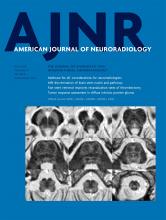We thank Drs Suss and Pinho for their interest in reading our article and sharing their opinion on the use of ASPECTS in patients with acute ischemic stroke. Several valid points have been raised about the limitations of ASPECTS, with which we agree.
Regardless of its limitations, ASPECTS is currently being used for treatment decision-making in patients with acute stroke who present <6 hours from symptom onset. This use is supported by a strong level of evidence that has emerged from randomized clinical trials and is included in the latest American Heart Association guidelines.1
Volume (of ischemic core) measurements if accurate and reliable can improve the screening process of patients with acute ischemic stroke and avoid several shortcomings of ASPECTS, including variability and ambiguity associated with the binary nature of ASPECTS.
While we have seen the successful use of ischemic core volume estimation obtained from CT perfusion or MR imaging to treat patients with stroke presenting beyond 6 hours from onset,2 current data on volumetric estimates of ischemic core via NCCT alone are limited. It is plausible that with a future successful large, prospective study, volumetric assessment of ischemic core on NCCT could potentially replace ASPECTS. This scenario may be not too far ahead, in particular considering the emergence of deep learning techniques with the potential for making this process even more reliable and effortless.3
- © 2020 by American Journal of Neuroradiology











